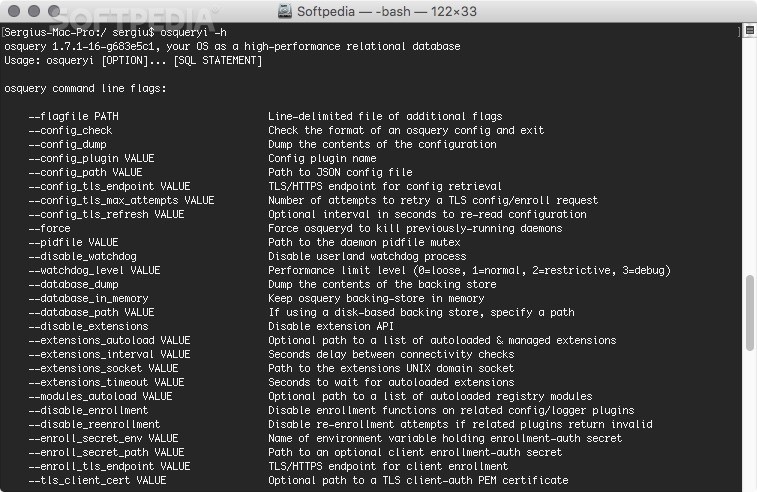
When you run Docker on the server and want to quickly see container count and per status count, query the docker_info table, as shown below. The result will be listed in descending order by the value of used memory. This query lists the top ten processes that use the most memory by querying the processes table. In cases where the system runs out of RAM, it would be good to check which processes may be experiencing high memory usage. This query would be helpful if you’d like to monitor if the files have changed. For example, the below query returns the SHA256 hash of the /etc/sudoers and /etc/passwd files. OSQuery can also calculate the file hash of a file by querying the hash table.
#Osquery tutorial free#
The query below returns the free and used space on the root drive ‘ /dev/root’ and all drives matching ‘ /dev/sd%1’. One of the crucial stats to monitor on a system is the storage space. When you need to monitor who logs on to a system, perhaps to catch unauthorized users and lock down access, you can run the below query. select computer_name,physical_memory,cpu_brand from system_info This query displays the computer name, memory size, and CPU brand of the local system. Now you know which fields you can return when you run a query. osqueryi ".schema "įor example, to display the system_info table schema: osqueryi ".schema system_info"Īs you can see below, the result returned all fields in the table. Tables have fields, and to find out which fields a particular table has, run this command in the interactive shell.schema But which tables are available? To find out, run the below command to list them. And in a database-like manner, you can run SQL queries against these tables.

Each table contains data about the system, including processes, users, etc.

Think of OSQuery as a database that has multiple tables. To get all available options and flags, run: osqueryi -help When used as a command-line tool, you can run osqueryi with options and flags. When inside the OSQuery shell, you can get help by running the. To enter the OSQuery interactive shell, run the below command. There are two ways to use the osqueryi tool: as an interactive shell and as a standalone command line tool. osqueryctl - The helper script to control the OSQuery daemon, such as stopping, starting, restarting, and checking the daemon status.You can use this command when manually and interactively running queries. osqueryi - The OSQuery interactive shell.This command can be used to schedule and run queries in the background. Once OSQuery is installed, you’ll have access to three components or commands.
#Osquery tutorial install#
Now, install the osquery package: sudo apt-get install -y osquery Install the OSQuery repository: sudo add-apt-repository \ OSQuery can be installed via the official OSQuery repository, which can be added to Ubuntu’s package manager using the following commands:Īdd the OSQuery GPG key to your machine: sudo apt-key adv -keyserver \ The first step in using OSQuery is to install it on your Ubuntu system. You can visit the OSQuery downloads page to see all available options. While OSQuery works on most platforms, this tutorial will use an Ubuntu Server 22.04 machine. We will cover various queries that can be used to monitor processes, users, network connections, and more.

#Osquery tutorial how to#
In this blog post, we will discuss how to install OSQuery on Ubuntu and how to use it to monitor your system. OSQuery is an open-source tool that provides a simple and effective way to monitor various aspects of your Ubuntu system. With the rise of cyber threats and attacks, having the right tools to monitor and protect your system is essential. System monitoring is crucial for maintaining the security and performance of any computer system.


 0 kommentar(er)
0 kommentar(er)
